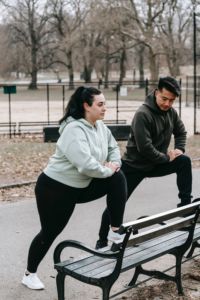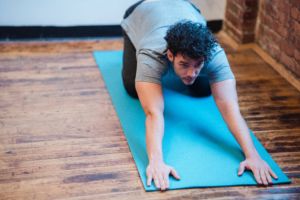Have you been thinking about starting a workout routine, but just don’t know where to start? There are many types of training out there, and it can be confusing and difficult to navigate where to begin, how to structure a routine, and how to choose the right kind of exercise for you. Maybe you already have a fitness routine but aren’t seeing results or getting satisfaction from it. Regardless of the reason, if you are looking to start or change your routine, it’s important to consider the different aspects of a well-rounded fitness plan.
 First off, a little bit of reflection can go a long way. Take the time to ask yourself why you want to exercise. What are your fitness goals? Are you satisfied with the results thus far? Understanding your own relationship to fitness will allow you to formulate a workout routine that emphasizes elements most relevant to your goals.
First off, a little bit of reflection can go a long way. Take the time to ask yourself why you want to exercise. What are your fitness goals? Are you satisfied with the results thus far? Understanding your own relationship to fitness will allow you to formulate a workout routine that emphasizes elements most relevant to your goals.
According to Dr. Jason Biondo, chiropractor and Director of Fitness at PALM Health, “If your goal is health and longevity, then you must have a balanced, well-rounded approach to your training. Each one of the training principles in a balanced approach works synergistically to improve your quality of life.”
A well-rounded fitness plan contains five elements: aerobic training, strength training, core training, balance training, and stretching. Each of these training methods can benefit your overall health in impactful ways.
Aerobic Training
Aerobic training is a form of exercise in which you’ve probably already participated in some capacity. This kind of training gets your heart rate up and your breathing rate going, which stimulates the pumping of blood to your heart and the delivery of oxygen to your working muscles. Swimming, running, water aerobics, and dance-based workout classes are all forms of aerobic exercise.
Because aerobic exercise requires your heart to pump at a higher rate for an extended period of time, in the long run, doing it consistently can actually train your heart to function more efficiently on a regular basis. This, in turn, improves your circulation and keeps your arteries clear, lowering your risk of cardiovascular disease and high blood pressure significantly.
 In addition to cardiovascular benefits, regular aerobic exercise can help you with weight loss, pain management, and mitigating the risks of other chronic conditions, like obesity, arthritis, metabolic syndrome, diabetes, some types of cancer, and stroke. Another important lasting effect of this kind of training, especially during this time, is improved immune function. When you participate in aerobic activities, it activates your immune system to help ward off infections. Over time, its function as a whole elevates to a higher level.
In addition to cardiovascular benefits, regular aerobic exercise can help you with weight loss, pain management, and mitigating the risks of other chronic conditions, like obesity, arthritis, metabolic syndrome, diabetes, some types of cancer, and stroke. Another important lasting effect of this kind of training, especially during this time, is improved immune function. When you participate in aerobic activities, it activates your immune system to help ward off infections. Over time, its function as a whole elevates to a higher level.
The long-term health benefits of consistently engaging in aerobic exercise are indispensable for improving your longevity, but there are also some immediate effects that you may feel which shouldn’t be overlooked. Going for a run, fast walk, swim, or doing an aerobic fitness class can elevate your mood by releasing endorphins and provide you with a boost of energy.
However, aerobic training is only part of what you need to be doing to work on your fitness. Cindy Vickers, personal trainer at PALM Health, cautions her clients against over-relying on aerobic exercises like walking. “You can walk for miles every day, but without core strength, muscular strength, and good balance, your overall fitness level will still be pretty low,” says Cindy. So, while aerobic training is great for you, it’s imperative to learn about and incorporate the other elements of a well-rounded fitness plan.
Strength Training
Did you know that as you age, your lean muscle mass diminishes naturally, while your body fat percentage increases? Strength training can help delay this process by replacing the lean muscle mass you lose over time. This kind of training involves using resistance to strengthen your muscles, which can involve anything from bodyweight exercises to resistance bands to free weights to weight machines — any exercise that induces muscle contraction.
When you train with some form of resistance, the muscles in the area of your body that you’re working all contract together to perform the exercise. Most strength training movements fall into one of two categories of contractions: isotonic contraction or isometric contraction. Both kinds of movement should be included in any strength training routine since they work your muscles in different ways.
Isotonic Movement
Isotonic contraction occurs when the actual length of your muscle changes. Within isotonic movements, your muscles contract concentrically and eccentrically. Concentric contraction occurs when your muscle shortens as it lifts the weight or resistance. Eccentric contraction occurs as your muscle lengthens.
Think about a biceps curl: your muscles contract concentrically and your biceps shortens as you curl the weight up, then it lengthens in an eccentric contraction as you lower the weight back down.
Isometric Movement
While isotonic movements change the length of your muscles as they contract, isometric movements do not. Isometric movements involve “holding” exercises that contract your muscles without shortening or lengthening them. Some examples of these exercises include wall sits, plank holds, overhead holds, glute bridge holds, and dead hangs.
So, where do you begin with strength training? When performing an exercise, start with your bodyweight or choose a weight or resistance level that is just heavy enough to tire out your muscles after 12-15 repetitions. Everyone’s starting weight will be different, but as long as you bring the muscle to fatigue — the point at which you can’t perform another repetition — your muscles are working the right way to build strength. Eventually, 12-15 repetitions at that resistance or weight level will start to feel easier, and that’s how you know it’s time to go heavier.
Building lean muscle through strength training is another useful tool for weight loss because lean muscle burns calories faster and more efficiently than other types of tissues. This can help you stay at a fit and healthy weight, especially as you get older. In addition to building muscle strength and mass, weight training also preserves bone density, thus working against the frailty that can come with age.
Core Training
“When you think about a hierarchy of training, core stability is the foundation. If this function is not well established, it will ultimately show up and hinder all other areas of training, which in the case of performance, can result in reduced outcomes or even injury,” says Dr. Biondo.
Proper form in both strength training and aerobic training is easier to maintain if you are stable from the inside out. When you work on your core strength regularly, you’re be less likely to get hurt elsewhere in your training and you get more out of your workouts.
Fitness aside, every movement you make when doing your daily tasks, from going up the stairs to swinging a tennis racket to lifting grocery bags, stems from your core, so building up that strength will always benefit your body’s stability.
Your core isn’t just your abs — it encompasses all the muscles around your spine, pelvis, and abdominal area, including your glutes, obliques, and upper and lower back muscles. A weak core can also contribute to poor posture, which can later result in back pain and neck pain.
“If we were to use the analogy of a race car, the engine provides the performance and horsepower, but the chassis (the core) is the foundation that holds it all together,” says Dr. Biondo.
Incorporating exercises like side bends, wood chops, dead bugs, and planks into your fitness routine will strengthen your core over time, improving your overall stability and mitigating risks for injuries and pain. Check out our blog on the basics of core training for more helpful tips.
Balance Training
Balance training may be new to you — oftentimes, it is not stressed much in fitness plans. But as you age, having good balance can prevent falls or help you avoid serious injury if you do fall. Working on balance exercises regularly as part of your exercise routine can help your body learn how to properly distribute weight in order to hold a stable standing position and move without falling.
Maggie Loida, another personal trainer at PALM Health, stresses the importance of balance training with her clients. “Not only is balance training important for improving your proprioception (the awareness of your body in space and in relation to the things around you), but it is also essential for strengthening your stabilizer muscles,” says Maggie. “The stronger your stabilizer muscles are in the ankles, knees, hips, and core, the less likely you are to suffer from falls.”
Not only does this kind of training improve your overall balance, but it can also sharpen your reaction time to loss of balance and improve your muscle tone, which provides more cushion for your bones and joints if you do fall.
It isn’t just your body that benefits from balance, though. Engaging in these exercises on a regular basis can actually improve your brain function as well. Balance training works your memory and spatial cognition and is great for neuroplasticity — the brain’s ability to modify and form new neural pathways in response to experience.
Balance improves with practice. Start with single-leg balance holds on the floor, then progress to double-leg balance holds on a balance pad, then single-leg holds on the balance pad. Eventually, you can try working on mobility exercises that incorporate balancing: for example, squats on a balance pad.
Stretching
Last but certainly not least, every fitness routine should involve stretching and flexibility exercises. Flexibility allows your muscles to lengthen and stretch in response to movement and provides your joints with the support they need to move fully and properly. With age, daily activities can become increasingly difficult and limited as a result of a natural decline in flexibility, but stretching routinely will help keep you mobile and flexible for much longer.
 Not only does stretching give you greater joint mobility, but it also can help improve your posture, increase muscle control, boost circulation, and release muscle tension and soreness, especially if you make a point to stretch after every workout. Long term, incorporating flexibility training into your fitness routine can offer you relief from chronic pain and arthritis as well.
Not only does stretching give you greater joint mobility, but it also can help improve your posture, increase muscle control, boost circulation, and release muscle tension and soreness, especially if you make a point to stretch after every workout. Long term, incorporating flexibility training into your fitness routine can offer you relief from chronic pain and arthritis as well.
Structuring Your Well-Rounded Fitness Plan
According to Maggie Loida, “Each of these elements is essential in training for variety and improvement, and the key to a well-rounded exercise plan is to cover every base to prevent injuries.” None of these types of training is superior to another, but finding a way to incorporate all of them into your routine will ensure that you are benefitting from a healthy mix of activity.
As far as aerobic training goes, adults should aim for 150 minutes of moderate-intensity activity or 75 minutes of vigorous activity per week. This can be broken up throughout the week in whatever way is most convenient for your schedule. If you’re having trouble gauging what “moderate” or “vigorous” activity looks like, here’s a useful guideline: with moderate aerobic activity, you should be able to talk while performing the exercise, but not sing. With vigorous aerobic activity, you should only be able to speak a few words before needing to take a breath.
Strength training is recommended 2-3 times per week in addition to your aerobic training, depending on your goals. If you’re looking to maintain your strength, two days per week is sufficient. If you’re looking to build muscle faster, three days will yield more results, especially if you train with working sets, in which you repeat the exercise until your muscle is completely fatigued and you continue until near failure. Aim for 12-18 working sets per muscle group spread across 2-3 training sessions in one week to see major improvement.
How does this break down? Let’s take the shoulder muscle group, for example. If you strength train twice in a week, you can perform six sets of shoulder exercises in each of those two sessions. These can be three different shoulder exercises with two sets of each, or two different shoulder exercises with three sets of each.
Core training, balance training, and stretching can easily be incorporated into your other training days. For example, core exercises and balance exercises can be implemented as part of your strength workouts. Stretching, on the other hand, is a healthy way to begin and end all of your workouts. While you’re still warm from your aerobic or strength workout, it’s best to do 2-4 rounds of stretching: pick a few static stretches and hold each one for 15-30 seconds. Repeat this cycle 2-4 times.
If you’re having trouble putting together a balanced exercise plan on your own or just want a little more guidance through the process, we have a Personalized Exercise Package at PALM Health to help you with just that. You’ll get a Personalized Exercise Assessment, where you’ll work with one of our trainers to see what your abilities and fitness needs are, followed by a Personalized Exercise Plan Review, where you’ll go over the fitness plan created for you by the trainer.
It’s never too late to start working on your fitness. There are plenty of ways to get into every type of training and personalize your plan to meet your needs. “No matter your age, the two most important things for you to bring to your training are a good understanding of form and a great sense of humor,” says Cindy Vickers. With an open and positive attitude, you’ll always be successful in your fitness goals.
PALM Health is an innovative lifestyle medicine and wellness center that offers a comprehensive range of advanced medical and wellness services, empowering people to transform their health and feel their best in mind and body.









